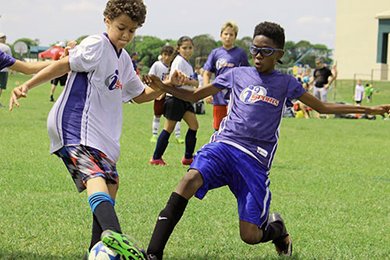Concussion Safety in Youth Soccer
Concussions from Heading a Soccer Ball
If you’re not familiar with soccer, heading can be an effective way for players to pass the ball or score when it’s in the air. Recent studies have shown that repeated heading of the ball (especially when done incorrectly) can be linked to concussions, subconcussive symptoms and cognitive impairment. According to the Concussion Legacy Foundation, over 30% of concussions in soccer are caused by heading the ball or falling over or colliding with another player while trying to head the ball.
Banning Heading in Youth Soccer
As a leader in youth sports safety, i9 Sports® was the first national youth sports organization to ban heading across all its leagues in 2011. It wasn’t until late 2015 that the U.S. Soccer Federation announced its U.S. Soccer Concussion Initiative which banned heading for children 10 and under (and limits heading for children 11 to 13 to 30 minutes per week).
The Concussion Legacy Foundation estimates that banning heading until high school will result in the prevention of 100,000 concussions among youth soccer players every three years.
In addition to preventing brain trauma injuries, banning heading will allow players to focus on improving foot skills instead.
Brandi Chastain, a two-time FIFA Women’s World Cup champion and two-time gold medalist believes “as a coach I would prefer my players had focused solely on foot skills as they develop their love of the game. I believe this change will create better and safer soccer.”
Soccer Concussion Safety Protocols
Concussion Safety Protocol is a key part of every i9 Sports® game play. Not only do we ban heading, we provide our parents and coaches with educational information on identifying concussions and apply our “When in Doubt, Sit Out” policy at all our games.
“We believe injuries, particularly head injuries, should never be an acceptable consequence of playing youth sports,” says Brian Sanders, president and CEO of i9 Sports®. “We take our leadership role in youth sports safety seriously because we don’t think kids and their parents should ever have to choose between fun and safety – we give them both.”

